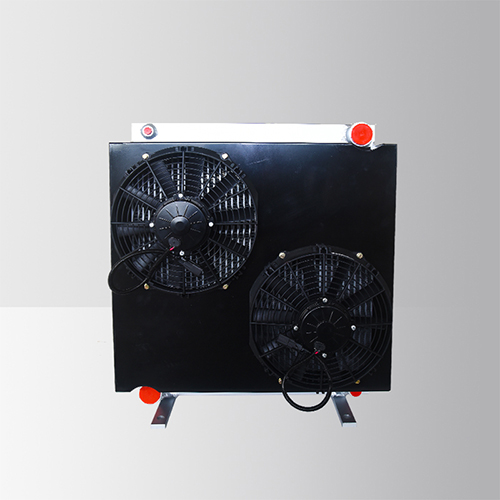Product Parameters
The noise value is a value at a distance of 1 m.
Dc Fan Heat Exchanger,Heavy Duty Truck Oil Cooler,Water To Oil Heat Exchanger,Water To Water Heat Exchanger Xinxiang Zhenhua Radiator Co., Ltd. , https://www.thermictransfer.com
First, "3" - three-tier network architecture
From the aspect of network topology, a medium- and large-scale high-definition network video surveillance system needs to adopt a three-tier network architecture: access layer, convergence layer, and core layer. The performance of each layer of the network architecture and the different access bandwidth are selected. The switch is different. 
1, the access layer:
You can select 8- or 16-channel Fast Ethernet switches. It is recommended that you control the number of cameras on the access switch at 6-10.
The actual bandwidth of our commonly used switches is 50%-70% of the theoretical value, so the actual bandwidth of a 100Mbit is 50M-70M. 4M*12=48M, so it is recommended that a 100M access switch should have access to a maximum of 12 720P network cameras. At the same time consider that the current network monitoring using dynamic encoding, the camera code stream peak value may exceed 4M bandwidth, while taking into account the bandwidth of redundant design, so a 100M access switch to control the best within 8 units, more than 8 units recommended Gigabit mouth.
2, the convergence layer:
The performance is higher than that of the access switch. You can select a Layer 2 switch with 1000 uplinks. The 100M Ethernet port of the switch is connected to the switch. The number of cameras connected to the gigabit port and the core switch of the monitoring center should be controlled at about 30 sets.
With the 720P network camera 4M bitstream calculation, each access layer switch on the front end has six 720P network cameras. The aggregation switch is connected with five access layer switches. The total bandwidth under the aggregation layer switch is 4M*6*5=120M. Therefore, the gigabit interface should be selected for the cascade port of the aggregation switch and the core switch.
3, the core layer:
The core switch is the core of the entire digital surveillance system, the next aggregation switch, uplink video surveillance platform, storage server, digital matrix and other equipment, it is recommended to select three full-gigabit core switches, the number of cameras exceeds 150 sets Consider three-tier 10G core switches .
Second, "2" - two important parameters
1. Backplane bandwidth The backplane bandwidth is the maximum amount of data that can be processed between the switch interface processor or interface card and the data bus. The backplane bandwidth marks the switch's total data exchange capability, in Gbps, also called switching bandwidth. The higher the backplane bandwidth of a switch, the stronger the ability to process data.
Backplane bandwidth calculation method: port number × port speed × 2 = backplane bandwidth.
Take the Huawei S1724G as an example. The switch has 24 Gigabit ports. Backplane bandwidth = 24 x 1000 x 2/1000 = 48 Gbps.
The backplane bandwidth is less than the nominal backplane bandwidth, so the switching device is linear at the backplane bandwidth, also known as non-blocking.
2, forwarding performance (the sum of the port packet forwarding rate)
Packet forwarding rate, also known as port throughput, refers to the packet forwarding capability of a router on a port. Units usually use pps (packet per second) to measure. In general, the low-end router packet forwarding rate is only a few K to several tens of Kpps, while high-end routers can reach several tens of Mpps (million packets per second) and even hundreds of Mpps.
The calculation method of packet forwarding rate: full configuration Gigabit ports × 1.488Mpps + full configuration 100Mbit ports × 0.1488Mpps = packet forwarding rate (a theoretical throughput of 1.488Mpps for a Gigabit port with a packet length of 64 bytes The theoretical throughput of a Fast Ethernet port at a packet length of 64 bytes is 0.1488 Mpps).
Take the Huawei S2700-26TP-SI as an example. The switch has 24 100Mbit ports and two Gigabit ports.
The packet forwarding rate = 2 x 1.488 Mpps + 24 x 0.1488 Mpps = 6.5472 Mpps.
The forwarding rate of the whole machine is ≤ the nominal packet forwarding rate. Then the switching equipment is in line speed on the whole forwarding. It is also called non-blocking.
Third, when selecting the type of attention:
1, for management convenience, optional WEB managed switch; 2, due to large video traffic, optional line-speed switch; 3, video data has a sudden feature, the greater the better the buffer cache; 4, the flow control of the switch Functions; 5. It is recommended that aggregation switches and core switches select well-known enterprise products.
The method is so simple, quickly take it away!
DC Driven Fan Bar Plate Heat Exchanger Series
Features:
Aluminum bar plate fin structure, coupled with high performance, the overall DC axial fan, small size, air volume is abundant, heat dissipation and efficient.
Application:
Hydraulic system return line, lubrication system cooling.
Construction machinery (cranes, pumps, etc.), lubrication systems, gearbox and so on.
Heat Transfer Capacity from 4-32HP
Optional (12/24V Motor)
Optional IP63 – IP68 waterproof
Technical Parameters:
DC fan standard for the brush suction style, in line with CE, UL, CUL standards.

Teach you to select network video monitoring switches every minute
At this stage, more and more high-definition cameras are used. How to select suitable switches that meet the requirements for monitoring the overall network architecture has also become very important in the early stage of high-definition monitoring system development and project quotations. A suitable switch not only can play the function of monitoring the network and can effectively reduce the waste of resources. The following Xiao Bian shares a bowl of dry goods with you so that you can get the network video surveillance switch by minute.